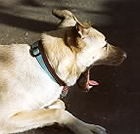| Revision as of 01:22, 21 July 2004 edit65.95.205.210 (talk) →External links: + Dr. Platek link← Previous edit | Revision as of 01:28, 21 July 2004 edit undoTimothyPilgrim (talk | contribs)Extended confirmed users2,472 edits →External links: <wasn't logged in when making addition>Next edit → | ||
| Line 18: | Line 18: | ||
| * | * | ||
| * | * | ||
| * | |||
| ] | ] | ||
Revision as of 01:28, 21 July 2004

A yawn is a reflex of deep inhalation and exhalation associated with being tired, with a need to sleep, or from boredom. The word "yawn" has evolved from the Middle English word yanen, an alteration of yonen, or yenen, which in turn comes from the Old English geonian. Yawning is a powerful non-verbal message with several possible meanings, depending on the circumstances:
- It can be an indication of tiredness, stress, over-work or boredom.
- An action indicating psychological decompression after a state of high alert.
- A means of expressing powerful emotions like anger and rejection.
A yawn can express strong anti-social messages, and so in some cultures people try to mute or mask them by placing a concealing hand over the yawning mouth.
Causes of yawning
A long-standing theory behind yawning is that yawning is caused by an excess of carbon dioxide and lack of oxygen in the blood. The brain stem detects this and triggers the yawn reflex. The mouth stretches wide and the lungs inhale deeply, bringing oxygen into the lungs and thence to the bloodstream. It is not certain however, that this hypothesis is correct; a more recent theory is that yawning is used for regulation of body temperature. Another theory is that yawns are caused by the same chemicals (neurotransmitters) in the brain that effect emotions, mood, appetite and other phenomena. These chemicals include serotonin, dopamine, glutamic acid and nitric oxide. As more of these compounds are activated in the brain, the frequency of yawning increases. Conversely, a greater presence in the brain of opiate neurotransmitters such as endorphins, reduces the frequency of yawning.
The yawn reflex is often described as contagious: if one person yawns, this will cause another person to "sympathetically" yawn. The reasons for this are unclear, possibly due to the "power of suggestion". Other theories suggest that the yawn serves to synchronize mood behavior among gregarious animals, similar to the howling of the wolf pack during a full moon. It signals tiredness to other members of the group in order to synchronize sleeping patterns and periods of activity. It can serve as a warning in displaying large, canine teeth thus proclaiming "don't attack while I am sleeping."
Adelie Penguins employ yawning as part of their courtship ritual. Penguin couples face off and the males engage in what is described as an "ecstatic display," their beaks open wide and their faces pointed skyward.